A new vaccine against typhoid rolls out in a flood-devastated province of Pakistan
- Impact
- A new vaccine against typhoid rolls out in a flood-devastated province of Pakistan
A new vaccine against typhoid rolls out in a flood-devastated province of Pakistan
4 November 2022
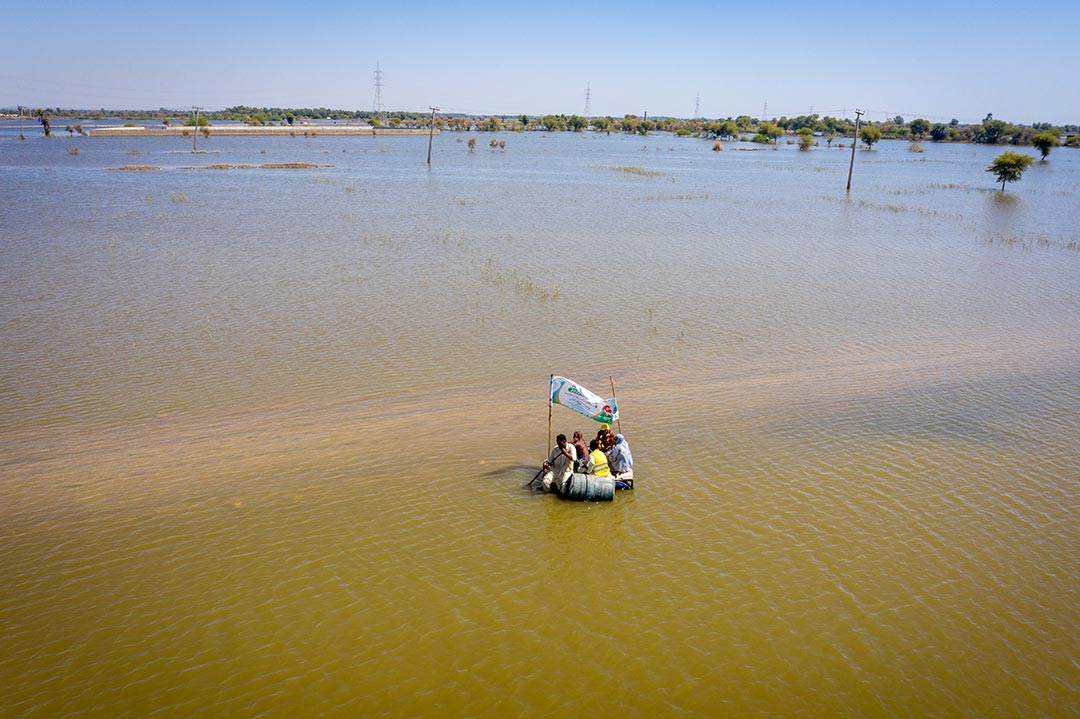
A vaccination team going on a boat (locally made with plastic barrels) to vaccinate children against Typhoid, during the TCV campaign in Sohbatpur city. Credit: Gavi/Asad Zaidi.
Armed with vials of Typhoid Conjugate Vaccine, health workers in Balochistan are doing what they can to protect children threatened by a pincer movement of global crises: antimicrobial resistance on the one hand and climate change on the other.
Announcements
IFFIm impact: typhoid
IFFIm has disbursed US$ 22 million to Gavi for typhoid conjugate vaccines and US$ 43.5 million for its typhoid conjugate campaign.
It was early October in Sohbatpur, Balochistan. The sky was clear, the sun was bright and electricity poles sprouted weirdly out of the floodwater. A metre or more above a sunken road, a raft made of a wooden charpoy and four plastic barrels lilted across the drowned town.
On board, four health workers and a punting boatman perched with the unperturbable repose of passengers waiting at a sleepy rural railway station. A vaccine cooler box and a sharps disposal container marked ‘biohazard’ rested between them. Overhead, a banner announced the vessel’s purpose like a flag: “Typhoid campaign” it read – “from 3-15 October, get your children from 9 months to 15 years vaccinated against typhoid.”

The campaign, the first-ever rollout of the Typhoid Conjugate Vaccine (TCV) in this province, was not designed as a disaster relief mission. Long-planned and already once-delayed by the COVID-19 pandemic, this was the final leg of a phased nationwide TCV introduction drive, aiming to add 5.5 million to the 30 million Pakistani children that have been immunised against Salmonella typhi in waves over the last three years.
But the monsoon this year poured a catastrophic quantity of water down on Pakistan. In August, Balochistan, one of two provinces and two administrative territories whose urban areas were targeted in this campaign, got seven times more rain than usual. At the end of that month, climate minister Sherry Rehman said that a third of the country was under water. By September, an estimated 10 million had been displaced nationwide – more than 600,000 of them sheltering in camps. Balochistan alone reported more than 240,000 houses wrecked or damaged.
Sluiced in contaminated, insect-thick water, communities in the flood zone were at heightened risk of epidemic diseases, including typhoid.
“Our entire area is drowned in water due to floods since last two months. My house is also under water. Elders, women, and kids are sick – with malaria, typhoid, measles.”
“It’s a waterborne disease, so the spread of typhoid can certainly increase in floods and crowded situations,” says epidemiologist Allyson Russell, Programme Manager for cholera and typhoid at Gavi. Conducting the TCV campaign became suddenly considerably more urgent, and much more difficult: “was it even going to be possible? A lot of the roads and bridges were destroyed, and a lot of the cold chain had been impacted,” Russell recalls thinking. “But the Pakistan country team, with support from Provincial EPI leadership and partner agencies on the ground, was really adamant. They reassured us and said: you know, it’s difficult, but we’ll find a way.”
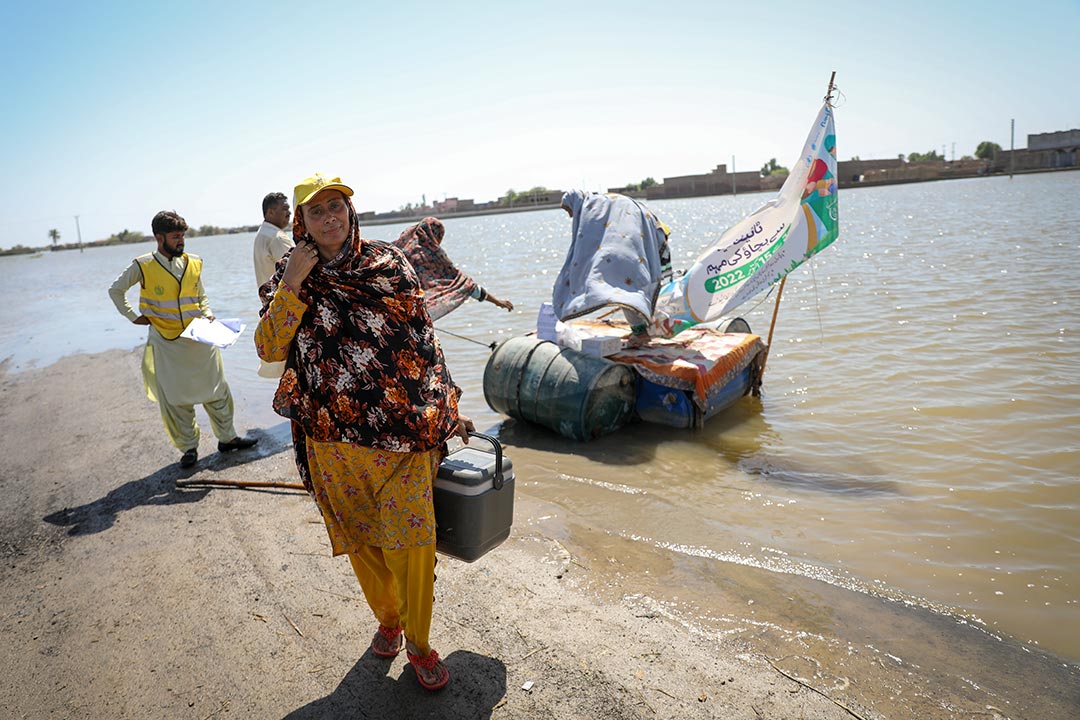
Credit Gavi/Asad Zaidi
In Sohbatpur, the barrel-and-charpoy ark scraped onto higher, dryer ground – a strip of tarmacked road now mistakable for a bridge. Its passengers disembarked. “We went by boat to vaccinate all the children – there were five kids needing TCV, five needing measles vaccine and four got polio drops,” reported Hakim Zadi, a midwife from the District Headquarters (DHQ) Hospital, smiling mildly.
Across Balochistan, health workers on the coalface of the TCV campaign were pulling double duty, stocking their vaccine cold-boxes with not only vials of the typhoid shot, but also with doses of Measles-Rubella and Oral Polio Vaccine; doing what they could to stifle the spread of other pathogens fuelled by the crisis conditions.
“Our entire area is drowned in water due to floods since last two months. My house is also under water,” Zadi said. “Elders, women, and kids are sick – with malaria, typhoid, measles.” In October, Balochistan recorded diarrhoea rates that were five times higher than normal, and more than one in nine children under five who were admitted to health facilities were suffering from severe acute malnutrition.
It wasn’t just a regular rough monsoon. In research published in September, scientists were able to demonstrate that the deluging rains were both made more likely and also exacerbated by climate change.
Everywhere in Jaffarabad district, tents stamped with the logo of the National Disaster Management Authority (NDMA) crowded the margins between roadways as dusty and perversely dry as bonemeal, and lakes that were only recently fields. The camps gave the impression of a disaster paused between rescue and recovery. Solar panels stood propped outside tent doors, radios chattered, cattle dozed under leaf-and-pole sunshades.
Displaced families like these lack access to sanitation facilities, said Dr Saleem Raza Jamali, District Health Officer. “In open defecation, the chance of an epidemic is very high.”

Credit Gavi/Asad Zaidi
Tethered goats offered gestures of futile defiance from tent entryways as the yellow-vested vaccinators made the rounds of the clustered children within. Syringes were drawn up, little arms bared. Toddlers cried tears of angry objection. Big kids made stoic big-kid faces. Zadi disposed of a used syringe and flashed a little girl a smile while an assistant coloured her pinky finger with permanent marker – a signal she was vaccinated. One more down, many more to go.
“The campaign we are working on is for poor and needy children,” she said. “We are giving them typhoid vaccinations so these children can be safe, and don’t get ill.”
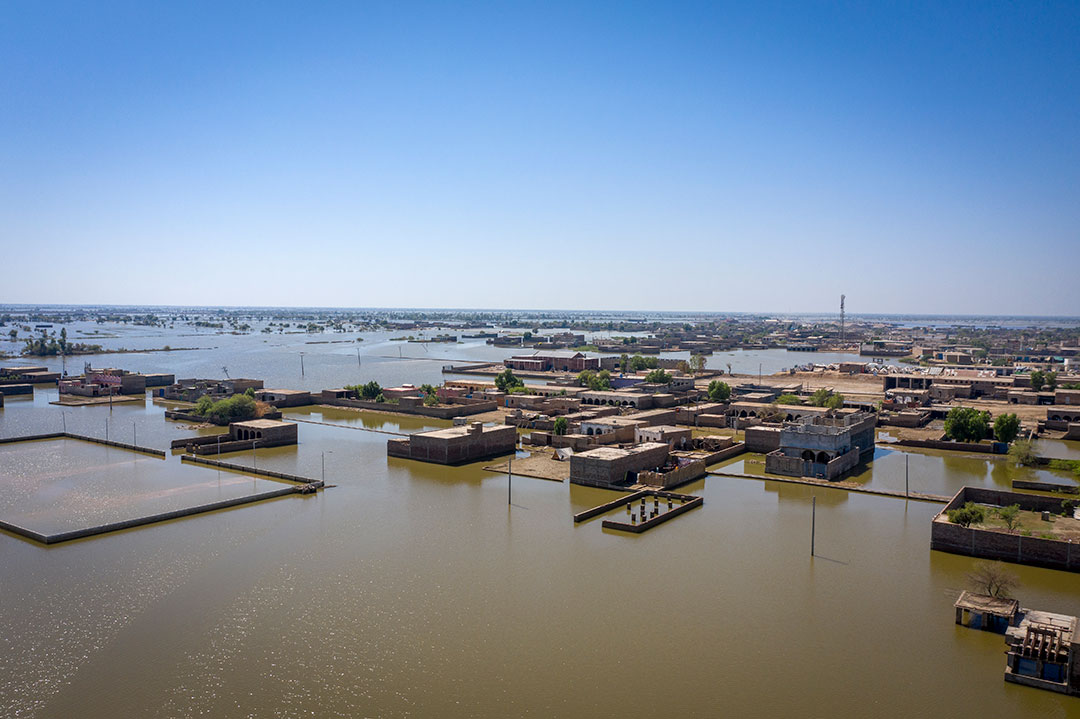
Credit Gavi/Asad Zaidi
It wasn’t just a regular rough monsoon. In research published in September, scientists were able to demonstrate that the deluging rains were both made more likely and also exacerbated by climate change. Temperatures reached absurd highs on the subcontinent earlier this year, with the city of Jacobabad in Pakistan aching in 51 degree heat one May day. The warmer air held more moisture; it accelerated glacial melt. Before Pakistan’s monsoon broke in earnest, meteorologists were issuing flood warnings.
Pakistan has been at the epicentre of the global spread of what is called Extensively Drug-Resistant Typhoid Fever (XDR-TF). It has now been reported in all provinces.
“Climate change is certainly changing the landscape of disease transmission and control . It’s not just flooding – it’s also droughts,” said Gavi’s Allyson Russell. The suggestion is plain: the picture confronting Balochistan’s battling health workers – the deluged homes, the starving kids, the barrel-raft – is not a glimpse of a bit of bad luck, but instead, the view from the vanguard of a planetary crisis.
In fact, Pakistan right now sits caught in the cross-current of two existential global health disasters: climate change on the one hand, and antimicrobial resistance (AMR) on the other.
Special envoy on AMR to the UK government Sally Davies recently made headlines when she compared the scale of the threat posed by AMR to the hazards of the climate crisis. They are also broadly comparable in terms of their inequitable distribution: both perils affect poor countries and poor communities disproportionately. A major study released earlier this year in the Lancet estimated that in 2019, 4.95 million deaths globally were associated with bacterial AMR. The highest rates of death occurred in sub-Saharan Africa and south Asia.
Drug-resistant typhoid is a particular scourge in Pakistan. Since 2016, when a large outbreak of typhoid fever that proved inert to the antibiotic ceftriaxone emerged in Sindh, Pakistan has been at the epicentre of the global spread of what is called Extensively Drug-Resistant Typhoid Fever (XDR-TF). It has now been reported in all provinces.
“Vaccination is really a cost-effective way to tackle AMR,” said Russell, noting that incidence of XDR typhoid has already declined in areas where the vaccine is in use.
WHO’s 2017 prequalification of the first typhoid conjugate vaccine – which offered longer-lasting immunity than previous typhoid jabs, and could be given to younger children – promised relief. Clinical trials pegged the vaccine’s efficacy at an impressive 80-85%, and a 2021 study showed that with ‘moderate deployment’, it was capable of curtailing a major outbreak of XDR-TF.
In 2019, with Gavi’s support, Pakistan began rolling out the jab in ‘catch-up’ drives that included not only toddlers but also teenagers. After October’s campaign, TCV will constitute part of Pakistan’s routine childhood immunisation schedule nationwide.
“Vaccination is really a cost-effective way to tackle AMR,” said Russell, noting that incidence of XDR typhoid has already declined in areas where the vaccine is in use. “You know, with AMR we are worried about the cost to families seeking healthcare. We’re also worried about health care systems being overwhelmed trying to treat an influx of complicated cases. And the best way to tackle this is to prevent the infections and reduce the overall spread of disease in the population.”
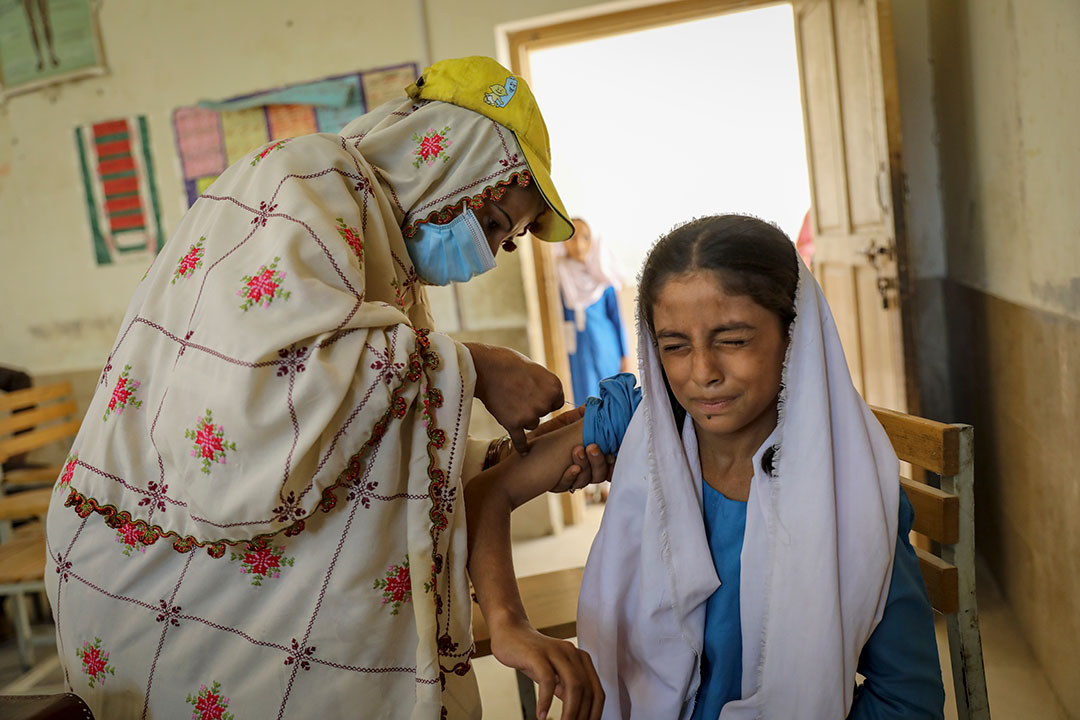
Credit: Gavi/Asad Zaidi
In Dera Allah Yar, the Jaffarabad district headquarters, the dry ground still sat so low over the water two months after the floods began that it had the provisional appearance of a scab, but one government middle school had dried out enough for lessons to resume
On a sunny Thursday, the vaccinators were paying the pupils a visit. In a classroom, girls in cornflower blue kameezes lined up for their shots. A teacher called Lubna Wahid looked on approvingly. “It’s a very good initiative,” she said. “My message for all mothers, teachers and people from other departments is that they should vaccinate their children to keep them healthy – so that it doesn’t affect their education.”
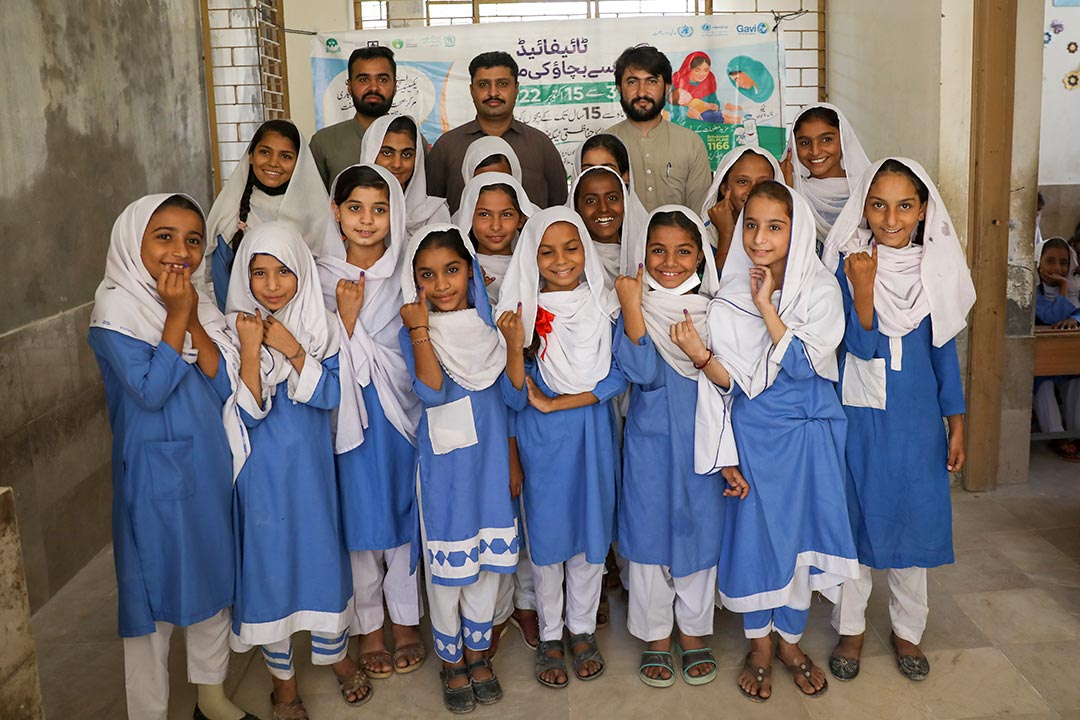
Credit: Gavi/Asad Zaidi
Nearly 26,000 schools nationwide – including this one – were damaged in the rains, disrupting classes for a cohort of students whose learning had already been knocked off-course by the COVID-19 pandemic. Immunisation, Wahid thought, offered a sliver of insurance against further interruption. In that sense, this campaign – which would, by it’s end, succeed in reaching its target of 5.5 million new children protected – was a vote in favour of an apparently elusive return to normalcy.
Behind the busy vaccinators, a blackboard bore traces of a recent English lesson. “The water in the stream and channels is flowing,” it read in chalk. “All the people get busy in the work. The cattle graze in the field.” Outside, in the fields, wading boys cast fishing lines.
 |
This article is republished from VaccinesWork under a Creative Commons license. Read the original article. |
Share this article
Restricted Access Library
 The material in this Restricted Access Library is intended to be accessed only by persons with residence within the territory of a Member State of the European Union and is not intended to be viewed by any other persons. The material in this Restricted Access Library is provided by IFFIm for information purposes only and the materials contained herein were accurate only as of their respective dates. Certain information in the materials contained herein is not intended to be, and is not, current. IFFIm accepts no obligation to update any material contained herein.
The material in this Restricted Access Library is intended to be accessed only by persons with residence within the territory of a Member State of the European Union and is not intended to be viewed by any other persons. The material in this Restricted Access Library is provided by IFFIm for information purposes only and the materials contained herein were accurate only as of their respective dates. Certain information in the materials contained herein is not intended to be, and is not, current. IFFIm accepts no obligation to update any material contained herein.
Persons with residence outside the territory of a Member State of the European Union who have access to or consult any materials posted in this Restricted Access Library should refrain from any action in respect of the securities referred to in such materials and are otherwise required to comply with all applicable laws and regulations in their country of residence.
By clicking Access restricted content: DYNAMIC-LINK-TEXT I confirm that I have read and understood the foregoing and agree that I will be bound by the restrictions and conditions set forth on this page.
The materials in this Restricted Access Library are for distribution only to persons who are not a "retail client" within the meaning of section 761G of the Corporations Act 2001 of Australia and are also sophisticated investors, professional investors or other investors in respect of whom disclosure is not required under Part 6D.2 of the Corporations Act 2001 of Australia and, in all cases, in such circumstances as may be permitted by applicable law in any jurisdiction in which an investor may be located.
The materials in this Restricted Access Library and any documents linked from it are not for access or distribution in any jurisdiction where such access or distribution would be illegal. All of the securities referred to in this Restricted Access Library and in the linked documents have been sold and delivered. The information contained herein and therein does not constitute an offer for sale in the United States or in any other country. The securities described herein and therein have not been, and will not be, registered under the U.S. Securities Act of 1933, as amended (the "Securities Act"), and may not be offered or sold in the United States except pursuant to an exemption from, or in a transaction not subject to, the registration requirements of the Securities Act and in compliance with any applicable state securities laws.
Each person accessing the Restricted Access Library confirms that they are a person who is entitled to do so under all applicable laws, regulations and directives in all applicable jurisdictions. Neither IFFIm nor any of their directors, employees, agents or advisers accepts any liability whatsoever for any loss (including, without limitation, any liability arising from any fault or negligence on the part of IFFIm or its respective directors, employees, agents or advisers) arising from access to Restricted Access Library by any person not entitled to do so.
"Relief" for mothers in Bayelsa state as malaria vaccine makes waves
07 November 2025
